Chronicling the Sixties
1 Educational Films
Zainichi are portrayed in a variety of educational films. Children of Japan depicts the friendship that develops between Korean children held in the Omura Detention Center in Nagasaki, and local Japanese children. Song of the Japan Sea is a work that takes up the theme of free passage between Japan and North Korea.
Children of Japan
(“Nihon no kodomotachi”)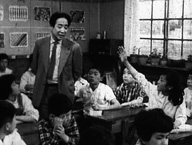 JAPAN / 1960 / Japanese / B&W / 16mm / 54 min
JAPAN / 1960 / Japanese / B&W / 16mm / 54 min
Director: Aoyama Michiharu
Script: Yagi Yasutaro
Original Story: Amamoto Misao
Photography: Maeda Minoru
Editing: Miyamori Miyuri
Sound: Oya Tadao
Music: Oki Masao
Art Director: Yamazaki Akira
Lighting: Suzuka Takao
Cast: Takahashi Masao, Iwamoto Kenichi, Nagata Hiromi, Kawakami Eiko, Kuwayama Shoichi
Planning: Nawa Katsuyoshi
Producers: Wakayama Kazuo, Eguchi Taisuke
Production Companies: Nagasaki Teachers and Staff Union, Shinseiki Eiga, Kyodo Eiga
Distribution, Source: Kyodo Eiga
This educational film for children is based on a composition written by an elementary school student in the sixth grade about the relationship between elementary school students in Nagasaki and Korean children who were detained as illegal immigrants. In the class discussion, the children exchanged their opinions on the news about the repatriation movement to North Korea, or the “illegal immigrant” issue. Because they had zainichi Korean classmates, they felt a kinship with the children living at the Omura Detention Center near their school, and arranged to visit it with their homeroom teacher’s guidance and help. Ogawa Shinsuke is said to have participated in this film as a line producer.
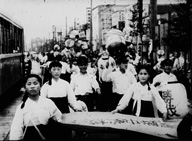 Song of the Japan Sea
Song of the Japan Sea
(“Nihonkai no uta”)- JAPAN / 1964 / Japanese / B&W / 16mm / 60 min
Director, Producer: Yamada Tengo
Script: Kataoka Kaoru
Photography: Ushiyama Kuniichi, Hamada Hideo
Editing: Nishioka Yutaka
Sound: Suzuki Shohei, Morimoto Yoshihisa, Takahashi Tatsuo
Music: Hara Rokuro
Planning: Mamiya Mosuke, Yamauchi Tatsuichi
Production Company: Gendai Productions
Source: Gendai Productions, Hokusei
Yamada Tengo from Gendai Productions, known as the leader of the
post-war independent film movement, chose the free movement of people between Japan and North Korea as the theme of his first film. With the support of Niccho (Nihon-Chosen) Kyokai and the General Council of Trade Unions of Japan, he spent four years making this film. The original was a longer documentary of ninety minutes, however the print shown here is an abridged version. It seems that in the original there is a scene at the end in which there are a series of shouts of “Kim Il-sung banzai!” The free flow of people across the Japan Sea for which this film advocates has yet to be realized.
2 TV Documentaries
Oshima Nagisa and Tsuchimoto Noriaki were both involved in the production of documentary programs in the early era of television. It is a great treat to be able to see these two films which take up the topic of zainichi on the big screen.
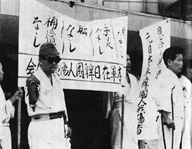 The Forgotten Imperial Army
The Forgotten Imperial Army
(“Wasurerareta kogun”)- JAPAN / 1963 / Japanese / B&W / Video (Original: 16mm) / 25 min
Director, Script: Oshima Nagisa
Photography: Shibata Sadanori, Suzawa Masaaki
Editing: Tomeo Kohei
Effects: Morimoto Takao
Narrator: Komatsu Hosei
Production Support: Noguchi Hideo, Hayasaka Akira
Producer: Ushiyama Junichi
Production Company: Nippon Television Network Corporation (NTV)
Source, In coorperation with: Nippon Audio-Visual Library
This is a highly regarded TV documentary by Oshima Nagisa. Oshima exposes the fact that many wounded soldiers cannot receive compensation from the Japanese government because of their Korean nationality, while questioning if this is a just way for the Japanese to act. The documentary uses TV to problematize the apathy of the Japanese people. According to Oshima’s The Idea of Evil and Cruelty and Sato Tadao’s History of Japanese Documentary Film, the actual situation was much more serious and harsher than the documentary depicts.
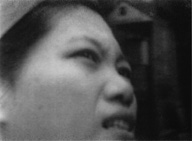 Civic War
Civic War
(“Shimin senso”)- JAPAN / 1965 / Japanese / B&W / Video (Original: 16mm) / 25 min
Director: Tsuchimoto Noriaki
Photography: Mishima Toshihiko, Itaya Kozo
Editing: Sugiyama Tadao
Sound Design: Iwami Kiyoshi
Narrator: Komatsu Hosei
Producer: Ushiyama Junichi
Production Company: Nippon Television Network Corporation (NTV)
Source, In cooperation with: Nippon Audio-Visual Library
Civic War is one of Tsuchimoto Noriaki’s early TV documentaries. War returnees and Koreans who have set up shop in the “International Market,” as it was called in Onomichi City, Hiroshima Prefecture, are given notice to voluntarily vacate the land as part of a port improvement plan. Referred to as squatters, residents unite in opposition. This documentary gives a detailed account of the negotiations between the city authorities and residents.
3 Film Movement in Osaka
Koh Hiroo organized the Osaka Independent Film Center and later continued to remain active in Osaka. Summer in Osaka, 1968, which could not be shown in the YIDFF 2003 Yamagata Newsreel! special program, was finally discovered this year.
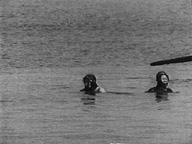 A Woman Diver in the Big City
A Woman Diver in the Big City
(“Daitokai no ama”)- JAPAN / 1965 / Japanese / B&W / Video (Original: 16mm) / 30 min
Director: Koh Hiroo
Production Company, Source: Nippon Eiga Shinsha
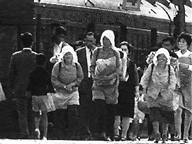 An episode from Series: Ningen, a TV program broadcast in 1965. This particular episode shows the day-to-day life of a woman diver originally from Jeju Island, South Korea, and lives in Ikaino, Osaka’s Koreatown. She survives by diving for turban shells and seaweed in the sea off Misaki Park at the south edge of Osaka Bay and then selling them. Because the show was made in the early days of TV broadcasting, there were no portable TV cameras for filming on location. Instead, a 16mm camera was used with B&W film. At the time, captions were not usually printed directly onto the film but were overlapped onto the image using a telop projector at the time of broadcast. The film here is shown without the telop, so there are no captions. The crew members, other than the director, are unknown.
An episode from Series: Ningen, a TV program broadcast in 1965. This particular episode shows the day-to-day life of a woman diver originally from Jeju Island, South Korea, and lives in Ikaino, Osaka’s Koreatown. She survives by diving for turban shells and seaweed in the sea off Misaki Park at the south edge of Osaka Bay and then selling them. Because the show was made in the early days of TV broadcasting, there were no portable TV cameras for filming on location. Instead, a 16mm camera was used with B&W film. At the time, captions were not usually printed directly onto the film but were overlapped onto the image using a telop projector at the time of broadcast. The film here is shown without the telop, so there are no captions. The crew members, other than the director, are unknown.
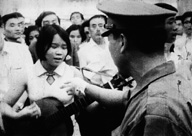 Summer in Osaka, 1968
Summer in Osaka, 1968
(“1968 Osaka no natsu, Hansen no kao”)- JAPAN / 1968 / Japanese / B&W / 16mm / 40 min
Staff: Ezoe Nobuaki, Suzuki Isao, Oba Shinichi, Sakata Minoru, Yamazaki Yoshihiro, Maki Itsuro, Ono Chohachi, Fukushima Hiroshi, Ogura Kunio, Hori Junichi, Yasunishi Kiyonao, Takemoto Atsuko, Kato Katsumi, Saito Takeo, Adachi Kotaro, Nitta Saburo, Kitanoma Atsushi, Koh Hiroo, Kuroda Michikume, Fujiwara Yukio, Nishino Ken
Production: Summer in Osaka production team, The Osaka Independent Film Center
Source: Kitanoma Atsushi
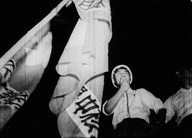 In concert with the events of May 1968 in Paris and other student movements throughout the world, the Osaka Independent Film Center was formed just before the 1970 protests against the renewal of the Japan-U.S. Security Treaty. This film documented the process of the escalating conflict, with all of its internal contradictions, leading up to International Anti-War Day. Koh Hiroo, who headed the Osaka Independent Film Center, endeavored to make this collective production with a group of nearly a hundred people. For a long time, the film could not be screened because all of the prints had been lost. However, a copy was found in the possesion of the former president of the Kinki chapter of the Independent Screening Organization, so it will be shown again for the first time in years.
In concert with the events of May 1968 in Paris and other student movements throughout the world, the Osaka Independent Film Center was formed just before the 1970 protests against the renewal of the Japan-U.S. Security Treaty. This film documented the process of the escalating conflict, with all of its internal contradictions, leading up to International Anti-War Day. Koh Hiroo, who headed the Osaka Independent Film Center, endeavored to make this collective production with a group of nearly a hundred people. For a long time, the film could not be screened because all of the prints had been lost. However, a copy was found in the possesion of the former president of the Kinki chapter of the Independent Screening Organization, so it will be shown again for the first time in years.
